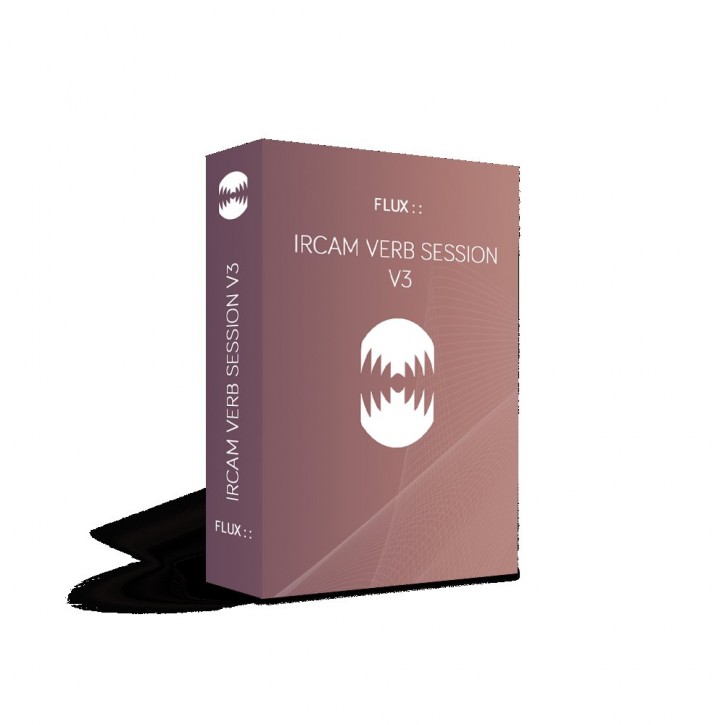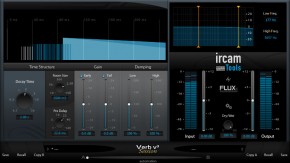Flux:: Ircam VERB Session v3
Hersteller: Flux::
Weitere Informationen:
http://www.flux.audio/project/ircam-verb-session-v3/
199,00 CHF
Produktbeschreibung
The Ultimate Session Reverb
VERB Session v3, based on the same fine technology used in the acclaimed IRCAM Verb v3, is tailored for simplicity providing a fast paced workflow for achieving the perfect result instantly. VERB Session v3 presents the ultimate reverb solution whether you are a seasoned session engineer or a demanding broadcast and post-production mixer.
All Features
Up to 2 channels Input/Output.
Input/Output gain controls for adjusting the levels before and after processing.
Dry/Wet control for blending the original signal with the processed signal.
Decay Time adjusting the duration of the reverberation tail in seconds.
Room Size adjusting the parameters for the early reflections part (early + cluster).
PreDelay controlling the time at which the reverberation portion of the effect starts to be heard, with respect to the DIRECT signal
Time Structure Settings; Early Gain, Tail Gain, Low Damping, High Damping
Filter Section adjusts the characteristics of the filter applied to the signal fed to the reverberation engine, affecting the overall frequency response, if required.
Preset and Parameter Handling
Preset/Parameter slots
To enhance the workflow the two Preset/Parameter slots, A and B, can be loaded with two full set of parameters at the same time. Apart from saving each preset, a “Global Preset” containing both the A and B settings, and the position of the “Morphing Slider”, can be saved.
Parameter Morphing Slider with Automation
The Morphing Slider provides morphing between the parameter settings of slot A/B allowing for really creative and useful real-time tweaking. Enabling the Automation control button exposes the Morphing Slider to the host automation.
Decay Time
The Decay Time, is the duration of the reverberation tail in seconds, the time it takes for the reverberated sound to die out. In technical terms this is often referred to as the RT60 factor, the time at which the response of the reverberation to an input signal goes below -60dB of attenuation.
Room Size
The Room Size is a meta parameter used to quickly perform a homogeneous set of parameters for the early reflections part (early + cluster). These parts are particularly important to achieve the “room” feeling of the desired space. It adjust the time structure of the whole reverberation (early-min, early-max, cluster-min, cluster-max, reverb-start).
Pre Delay
The Pre Delay controls the time at which the reverberation portion of the effect starts to be noticed, with respect to the DIRECT signal. Increasing this helps to distinguish between direct and effected sound and preserve intelligibility, especially with large decay times and room sizes which would otherwise drench the audio material in reverberation.
Time Structure Gain and Damping
Early Gain - Controls the level of EARLY and CLUSTER contributed to the overall effect.
Tail Gain - Controls the level of LATE/TAIL contributed to the overall effect.
Low Damping - Adjusts low-frequency damping, for increasing or decreasing the decay of bass content with respect to the rest of the spectrum
High Damping - Adjusts high frequency content damping.
Filter Section
The Filter Section controls the characteristics of the filter applied to the signal fed to the reverberation engine, affecting the overall frequency response, if required.
Low Freq - Low pass filter frequency cutoff of the corresponding filter section.
High Freq - High pass filter frequency cutoff of the corresponding filter section
Dual Preset Slots and Parameter Morphing
The built in preset manager and the preset morphing slider, provides instant and intuitive control of all parameters and controls. In a second, with a simple one-click operation, everything is copied from one of the two preset slots to the other, even during playback.
Details:
The two Preset/Parameter slots, A and B, can be loaded with two full set of parameters at the same time, and except for only A/B comparing two sets of parameters, the morphing slider will allow to mix them, and to record the morph with the host automation.
Specifications
Availability
Ircam VERB Session v3 is available in the following configurations:
Native – AU / VST / AAX Native
Processing
VERB Session v3, as all Flux:: plug-ins, provide
64-bits internal floating point processing.
Sampling rate up to 192 kHz for native (VST/AU/AAX/AAX AudioSuite).
Virtual Head
This plugin relies on HRTF filter measurements made using a KEMAR (Knowles Electronics Manikin For Acoustic Research) dummy head and torso simulation. This type of manikin was conceived during the 1970’s for conducting acoustics experiments using a model with anthropometric dimensions equivalent to that of an average human listener.
Virtual Speakers
The audio input is routed internally to virtual speakers, through a routing matrix. These represent the emulated loudpseaker setup configuration.
Hardware Requirements
A graphic card fully supporting OpenGL 2.0 is required.
Mac OS X: OpenGL 2.0 required – Mac Pro 1.1 & Mac Pro 2.1 are not supported.
Windows: If your computer has an ATi or NVidia graphics card, please assure the latest graphic drivers from the ATi or NVidia website are installed.
Software Licence Requirements
In order to use the software an iLok.com user account is required (the iLok USB Smart Key is not required).
Compatibility
All major native formats are supported
Windows – 7 SP1, 8.1 and 10, all in 64 bits only.
VST (2.4)
AAX Native*
Mac OS X (Intel) – from 10.7.5 (64bit version) to 10.13.4
VST (2.4)
AU
AAX Native*
* AAX Native & AAX AudioSuite in Pro Tools 11 and 12
Due to AVID ProTools changing to AAX, from Version 3 (v3) RTAS for AVID ProTools is no longer supported.
Weitere Informationen: http://www.flux.audio/project/ircam-verb-session-v3/
Bewertungen


